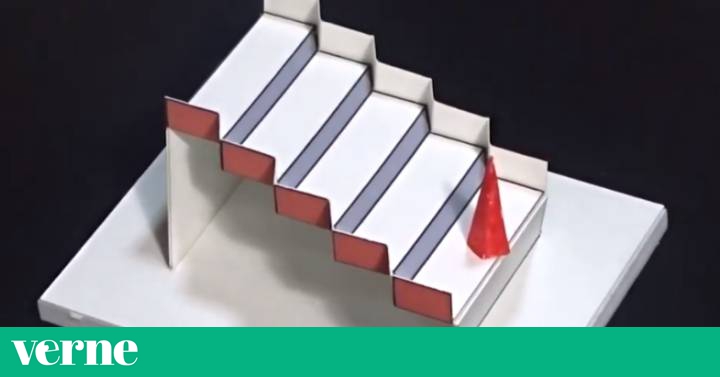Optical illusions aren't just hobbies, that would be fine by now.
They also help us understand how perception works, by giving us clues about the operations that the brain carries out to construct and interpret what we see.
This Friday the three best illusions created in 2020 have been known, according to The Illusion Of The Year Contest.
Susana Martínez-Conde, director of the Integrative Neuroscience Laboratory at the State University of New York, has been organizing this contest since 2005, when it started in her hometown, A Coruña.
A group of experts selected the ten finalist illusions, and the three winners of this 16th edition have been decided by voting on the awards website.
1. A Schröder staircase in 3D
The winning illusion is the work of Kokichi Sugihara, a mathematician at the Japanese University of Meiji.
Sugihara reinterprets a classic illusion created in 1858 by scientist Heinrich GF Schröder, and remakes it in three dimensions.
On this ladder, the cone at one end appears to be up or down, depending on whether we rotate the object 180 degrees.
Martínez-Conde explains to
Verne
that perspective is one of the keys: if the camera were slightly higher or lower, the effect would be lost.
He also points out that naturally it might be easier to distinguish that there is no change in height on the surface of the object.
Sugihara is one of the regulars of this contest: he won it in 2018, with an object that presented a triple ambiguity, and in 2016 he was second with another similar work, cylinders that seemed completely different when reflected in the mirror.
2. The authentic
In the second awarded work we see a series of illusions in which a frame conditions us to believe that we are in front of a mirror, as in the scene of the Marx brothers in
Goose Soup
.
The illusion persists even when we eliminate factors that help us think that we are in this situation, such as funds.
The author of the illusion, the magician and science popularizer Matt Pritchard, warns us in the description of the illusion that, no matter how little we look at it, we will see discrepancies in the image without causing the effect to disappear.
Regarding the latter, Martínez-Conde explains that the fact that Pritchard's work starts from everyday objects, the can and the mirror, which we think we know very well influences.
"Our brain tends to make predictions," he explains, and when faced with ambiguous information and incompatible possibilities, "it plays with the odds."
If we see a frame and two equal objects opposed, it is easier to think that it is a mirror, because it is the most common interpretation.
Until we see discrepancies that draw our attention, we do not go into analyzing the details.
3. The impossible grid topography
The third prize goes to the designer Daniël Maarleveld, who also shows impossible objects in 2D.
"What is new and original about this illusion - explains Martínez-Conde - is the movement."
In the image we see how, for example, the lower part of an object seems to be the upper part, or the front part becomes the front.
We are, again, before ambiguous information and, in addition, the movement makes "our brain continually question reality, re-evaluating its interpretation."
Apart from these winning illusions, Martínez-Conde stands out among the other seven finalists that of these ladybugs, created by Mark Wexler, Patrick Cavanagh and Stuart Anstis, from the universities of Paris, York and California-San Diego.
The insect appears to change position, showing "how important context is to our perception."
This other one also stands out in which the subtitles seem to be closer the faster they move.
You don't remember what was described before.
And finally, this one in which we can create the illusion that a knife is transparent and that we can also recreate at home.
Similar to the illusion of Pritchard and the mirror, in the images there are details that contradict this interpretation, such as other reflections of the text on the knife, but continuity in the tines of the fork prevails.
* You can also follow us on Instagram and Flipboard.
Don't miss out on the best of Verne!

